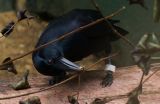Methanotrophs: Could bacteria help protect our environment?
2015-08-26
(Press-News.org) New insight into methanotrophs, bacteria that can oxidise methane, may help us develop an array of biotechnological applications that exploit methane and protect our environment from this potent greenhouse gas.
Publishing in Nature, scientists led by Newcastle University have provided new understanding of how methanotrophs are able to use large quantities of copper for methane oxidation.
They have identified a new family of copper storage proteins called Csp that are present in a range of bacteria. These proteins store metal in a way that has not been seen previously and their widespread presence amongst diverse bacteria raises important questions about how bacteria use copper ions, which can also be toxic to cells.
The potential
Methane availability is rising as the extraction of natural gas booms, and more methane is escaping into the atmosphere. Methanotrophs are the primary biological mechanism for mitigating the release of methane by consuming it for carbon and energy. These organisms also have great potential in the biotechnological utilisation of methane, a readily renewable carbon source, for the production of bulk and fine chemicals and sustainable energy.
To oxidise methane, methanotrophs use an enzyme called methane monooxygenase whose essential cofactor is copper (some can also use iron). Understanding how methanotrophs handle copper is therefore of great importance for all potential applications of these organisms.
The scientists describe the discovery and characterisation of Csp1 from a methanotroph that can bind large quantities of copper and propose this is a protein that accumulates copper for methane oxidation.
Lead author Chris Dennison, Professor of Biological Chemistry at Newcastle University explained: "Methane is such a useful and plentiful commodity but we need more cost effective methods to unlock its potential. Using bacteria could be the best option so a better knowledge of how these bacteria operate is required.
"As copper is so important for the oxidation of methane, all potential applications based on this reactivity requires knowing how methanotrophs acquire and store copper. The discovery of the Csps adds a new dimension to our understanding of this complex process."
Co-author Colin Murrell, Professor in Environmental Microbiology at the University of East Anglia, commented: "We have known that copper is a vital element for biological methane oxidation for over thirty years and this new information will really help us to formulate new strategies for exploiting these bacteria both in the laboratory and in the environment."
Method
Metalloproteomics was used to discover Csp1 in a highly complex mixture of proteins. The analysis of recombinant Csp1 using an array of biochemical and biophysical techniques has allowed copper binding by Csp1 to be understood at the molecular level. This includes determination of Csp1 crystal structures using the facilities at Diamond Light Source. A genetically modified methanotroph has been generated to demonstrate the physiological function of Csp1.
Dr Neil Paterson, a post-doctoral research associate at Diamond Light Source, said: "The ability of Diamond Light Source to provide tuneable X-ray energy allowed us to use the intrinsic copper ions within the protein to solve the crystal structure by X-ray diffraction and also define their oxidation state through X-ray fluorescence spectroscopy."
Structure
Csp1 possesses a four-helix bundle fold, a well-established structural motif for proteins. The striking feature of Csp1 is that multiple cysteine residues, known to avidly bind copper, point into the core of the bundle that suggested a novel way of storing a metal. Copper-binding studies and the crystal structure of the protein with copper provide a detailed insight into how the four-helix bundle of Csp1 can be filled with copper ions.
INFORMATION:
Reference:
A four-helix bundle stores copper for methane oxidation.
Nicolas Vita, Semeli Platsaki, Arnaud Baslé, Stephen J. Allen, Neil G. Paterson, Andrew T. Crombie, J. Colin Murrell, Kevin J. Waldron, Christopher Dennison.
Published in Nature. DOI: 10.1038/nature14854
ELSE PRESS RELEASES FROM THIS DATE:
2015-08-26
It's not a huge mystery why Los Angeles experiences earthquakes. The city sits near a boundary between two tectonic plates -- they shift, we shake. But what about places that aren't along tectonic plate boundaries?
For example, seismicity on the North American plate occurs as far afield as southern Missouri, where earthquakes between 1811 and 1812 estimated at around magnitude 7 caused the Mississippi River to flow backward for hours.
Until now, the cause of that seismicity has remained unclear.
While earthquakes along tectonic plate boundaries are caused by motion ...
2015-08-26
The Pacific Northwest is abundantly dotted with wildfires in Washington, Oregon, Idaho and Montana. There are over 27 fires listed in the Inciweb database for the state of Washington. The largest active fire listed is the Okanogan Complex Fire which is currently at 256,567 acres and has 1,250 personnel working the fire. This fire began as a lightning strike on August 15, 2015. It is only 10% contained at present. Governor Inslee's request for a federal Emergency Declaration to provide additional resources to cover some of the costs related to multiple wildfires burning ...
2015-08-26
Mostly untouched for 100 years, 15 Roman-era Egyptian mummy portraits and panel paintings were literally dusted off by scientists and art conservators from Northwestern University and the Phoebe A. Hearst Museum of Anthropology as they set out to investigate the materials the painters used nearly 2,000 years ago.
What the researchers discovered surprised them, because it was hidden from the naked eye: the ancient artists used the pigment Egyptian blue as material for underdrawings and for modulating color -- a finding never before documented. Because blue has to be manufactured, ...
2015-08-26
UC San Francisco researchers have for the first time developed a method to precisely control embryonic stem cell differentiation with beams of light, enabling them to be transformed into neurons in response to a precise external cue.
The technique also revealed an internal timer within stem cells that lets them tune out extraneous biological noise but transform rapidly into mature cells when they detect a consistent, appropriate molecular signal, the authors report in a study published online August 26 in Cell Systems.
"We've discovered a basic mechanism the cell uses ...
2015-08-26
Companies can promote creativity in employees by encouraging them to network beyond their immediate business networks, according to a new study by management experts at Rice University, Australian National University (ANU), Erasmus University Rotterdam, Monash University in Clayton, Australia, and the University of Los Andes in Bogota, Colombia.
"Social networks can be important sources of information and insight that may spark employee creativity," the authors said. "The cross-fertilization of ideas depends not just on access to information and insights through one's ...
2015-08-26
CAMBRIDGE, Mass.--For more than a decade, gene sequencers have been improving more rapidly than the computers required to make sense of their outputs. Searching for DNA sequences in existing genomic databases can already take hours, and the problem is likely to get worse.
Recently, Bonnie Berger's group at MIT's Computer Science and Artificial Intelligence Laboratory (CSAIL) has been investigating techniques to make biological and chemical data easier to analyze by, in some sense, compressing it.
In the latest issue of the journal Cell Systems, Berger and colleagues ...
2015-08-26
Among our greatest achievements as humans, some might say, is our cumulative technological culture -- the tool-using acumen that is passed from one generation to the next. As the implements we use on a daily basis are modified and refined over time, they seem to evolve right along with us.
A similar observation might be made regarding the New Caledonian crow, an extremely smart corvid and the only non-human species hypothesized to possess its own cumulative technological culture. How the birds transmit knowledge to each other is the focus of a study by Corina Logan, a ...
2015-08-26
Two studies and an editorial published online by JAMA Psychiatry examine associations between cannabis use and the brain.
Cannabis, also known as marijuana, is a popular recreational drug and its legal status has been a source of enduring controversy.
In the first study, David Pagliaccio, Ph.D., formerly of Washington University in St. Louis, and now at the National Institute of Mental Health, Bethesda, Md., and coauthors analyzed data from a group of twin/siblings (n=483 with 262 participants reporting ever using cannabis in their lifetime) to determine whether cannabis ...
2015-08-26
Toronto, CANADA - Male teens who experiment with cannabis before age 16, and have a high genetic risk for schizophrenia, show a different brain development trajectory than low risk peers who use cannabis.
The discovery, made from a combined analysis of over 1,500 youth, contributes to a growing body of evidence implicating cannabis use in adolescence and schizophrenia later in life.
The study was led by Baycrest Health Sciences' Rotman Research Institute in Toronto and is reported in JAMA Psychiatry (online) today, ahead of print publication.
Adolescence is a period ...
2015-08-26
Putnam Valley, NY. (Aug. 26, 2015) - Liver transplantation is currently the only established treatment for patients with end stage liver failure. However, this treatment is limited by the shortage of donors and the conditional integrity and suitability of the available organs. Transplanting donor hepatocytes (liver cells) into the liver as an alternative to liver transplantation also has drawbacks as the rate of survival of primary hepatocytes is limited and often severe complications can result from the transplantation procedure.
In an effort to find potential therapeutic ...
LAST 30 PRESS RELEASES:
[Press-News.org] Methanotrophs: Could bacteria help protect our environment?

